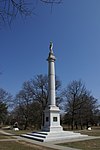Siege of Fort Mifflin

The siege of Fort Mifflin or siege of Mud Island Fort from September 26 to November 16, 1777 saw British land batteries commanded by Captain John Montresor and a British naval squadron under Vice Admiral Lord Richard Howe attempt to capture an American fort in the Delaware River commanded by Lieutenant Colonel Samuel Smith. The operation finally succeeded when the wounded Smith's successor, Major Simeon Thayer, evacuated the fort on the night of November 15 and the British occupied the place the following morning. Owing to a shift of the river, Fort Mifflin is currently located on the north bank of the Delaware adjacent to Philadelphia International Airport. After General Sir William Howe's British-Hessian army occupied Philadelphia, Pennsylvania on September 26, 1777, it became necessary to supply his troops. Fort Mifflin on Mud Island in the middle of the Delaware and Fort Mercer at Red Bank, New Jersey, together with river obstructions and a small flotilla under Commodore John Hazelwood prevented the Royal Navy from shipping provisions into the city. With Philadelphia effectively blockaded by the Americans, the Howe brothers were forced to lay siege to Fort Mifflin in order to clear the river. A Hessian attempt to storm Fort Mercer failed with heavy losses on October 22 in the Battle of Red Bank. Two British warships which had run aground near Mud Island were destroyed the next day. General George Washington reinforced Fort Mifflin throughout the siege, but the garrison never numbered more than 500 men. After a few setbacks, the British finally assembled enough artillery and warships to bring Fort Mifflin under an intense bombardment beginning on November 10. No longer able to reply to the British bombardment, Thayer ordered the survivors to row across to New Jersey in the night and left the flag flying. Fort Mercer was abandoned soon afterward, opening the Delaware and permitting the British to hold Philadelphia until June 1778.
Excerpt from the Wikipedia article Siege of Fort Mifflin (License: CC BY-SA 3.0, Authors, Images).Siege of Fort Mifflin
Fort Mifflin Road, Philadelphia
Geographical coordinates (GPS) Address Website Nearby Places Show on map
Geographical coordinates (GPS)
| Latitude | Longitude |
|---|---|
| N 39.87494 ° | E -75.21319 ° |
Address
Fort Mifflin
Fort Mifflin Road
08063 Philadelphia
Pennsylvania, United States
Open on Google Maps







